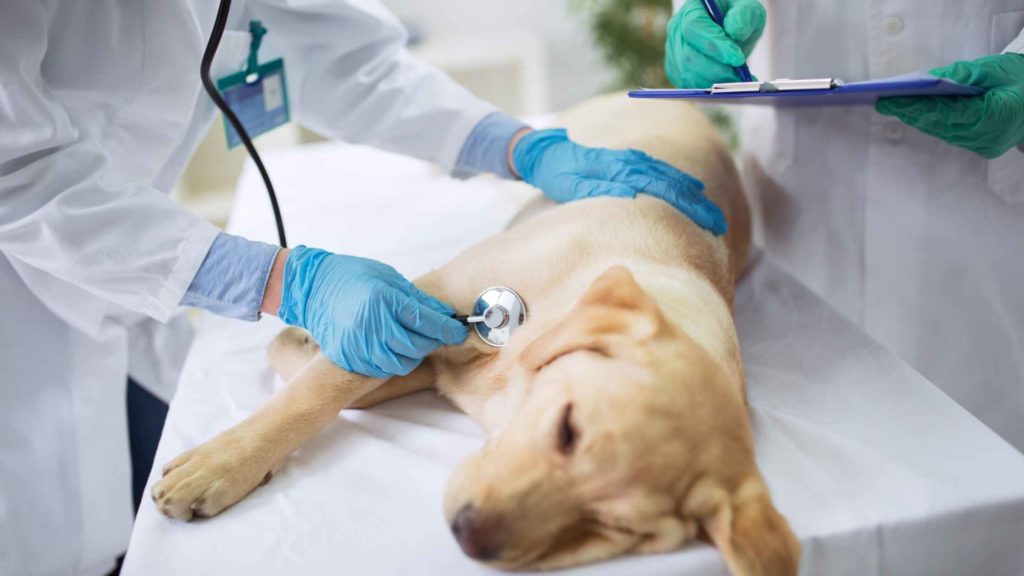
Finding out your dog has lymphoma is heartbreaking, but finding out that you must euthanize your dog is even more so. If this is a situation you face, here are some tips to help you with this impossible decision and situation.
Deciding to euthanize a dog with lymphoma will be a difficult one that you should do with the assistance of a vet or other specialist. General signs that it’s time to say goodbye include your dog no longer feeling better after treatments, losing their appetite, or losing their quality of life overall.
What is lymphoma in dogs?
Lymphoma in dogs is much the same as lymphoma in humans. It’s a type of cancer that creates an abnormality of the white blood cells in the lymphatic system.
These abnormalities interrupt the function of the white blood cells and take over the various lymph nodes in the body. In humans, lymphoma can be managed with aggressive treatment and often offer remission.
In dogs, remission is temporary rather than permanent. In lower stage diagnoses, remission can last up to several years, if not longer. Cancer will eventually return, however. In later stages, most of the focus will be on slowing down its progression to offer the dog longer.
Types of lymphoma in dogs
There are four types of lymphoma in dogs. Arranged in order of how commonly they are diagnosed, these are:
- Multicentric lymphoma
- Alimentary lymphoma
- Mediastinal lymphoma
- Extranodal lymphoma
Multicentric lymphoma
This is a kind of lymphoma where the lymph nodes swell up quickly and become visible early in diagnosis and treatment. This is considered the dog version of non-Hodgkin’s lymphoma, which is the most common form of lymphoma in humans.
Alimentary lymphoma
The second most common kind of canine lymphoma, this particular type, is concentrated in the intestines and often has little to no symptoms. This often progresses to later stages before it’s picked up since its symptoms are diarrhea and vomiting, rather than visible lumps. This kind of cancer tends to stay concentrated in the gut area.
Mediastinal lymphoma
This third most popular kind of cancer will have enlarged lymph nodes, mainly in the chest area. Sometimes they can spread to the neck and the face. This is often the most “visual” type of lymphoma since the tumors are in those commonly seen areas.
Extranodal lymphoma
This is a rare form of lymphoma; there is still a lot that experts don’t know about it. They agree that it is the only form of lymphoma that doesn’t impact the lymph nodes. That is, it is a lymphoma, but it will cause swelling in the eyes, the kidneys, the Central Nervous System (CNS), etc. Thankfully, this sneaky kind of cancer is rarest.

Causes for lymphoma in dogs
Much like humans, experts aren’t sure of the exact cause of lymphoma. However, the most common connection for lymphoma diagnoses is exposure to herbicides or a magnetic field for prolonged periods of time.
Certain dog breeds are thought to be predisposed to cancer, and lymphoma in particular. This is something that you can use in your favor, though, since your vet will know to do screenings regularly and watch for any kind of symptoms to make sure that it’s detected early and will give your dog the best chance at life.
Is a dog in pain with lymphoma?
Dogs with lymphoma can often be in pain, though it depends mainly on the kind of lymphoma and how severe it is. Those with stages 1 or 2 will be relatively comfortable or pain-free. Stage 3 and 4 cancer can be painful, though. This is part of the decision to think about when considering euthanasia—more on that in a bit.
The life expectancy of dogs with lymphoma
As mentioned, lymphoma — even when caught early and treated into remission — does tend to come back with dogs later in life. Since lymphoma is a very aggressive cancer, this makes sense when you compare it to other kinds of cancer.
As far as life expectancy is concerned, it depends on what stage the cancer is detected and what treatment options you choose for your dog. On average, about 20% of treated dogs will survive up to 3 years. Treatment includes chemotherapy and surgery in many cases.
How fast does lymphoma in dogs progress?
This depends on what stage it’s caught. Most experts agree that the progression of lymphoma is fast, but the actual speed is going to be determined mainly by your dog’s overall status and the stage of cancer combined.
- Stage 1: one lymph node impacted
- Stage 2: local lymph nodes enlarged and impacted
- Stage 3: the liver or spleen become impacted
- Stage 4: bone marrow and blood infected
The more aggressive the cancer is, the higher the stage and the faster the progression. Specialized care is integral to help slow it down as much as possible. If you leave your dog’s cancer untreated, it will progress much faster.
Has any dog survived lymphoma?
With early intervention, dogs can survive many years after their diagnosis and treatment. However, there is no cure for lymphoma in dogs, so experts agree that it will simply prolong your dog’s life.
How to make a dog with lymphoma comfortable
It’s challenging for pet parents to see their dogs suffering from lymphoma, but the good news is that you can do a lot to help your dog weather the storm! Here are some tips:
- Use whatever pain medication you can
- Adjust your life to caring for them
- Prioritize daily care
- Follow their symptoms and signs
- Focus on stress relief
When it comes to the actual ease of care, the focus will be on supporting your dog and their needs. Pain medication is often prescribed during chemotherapy and after surgery. While it’s understandable that you want to save some costs, it’s a good idea to take that pain medication to give to your dog since it will ease their discomfort.
You’ll need to adjust your life to caring for them in the sense of making sure you log what they eat, when, when their symptoms are bad, any kind of things that you’re noticing with body language, etc. The best care they can receive comes from accurate logging and daily care from their pet parent.
As they show symptoms, update your vet, and they can adjust care in pain medication or suggestions on a diet to help support as much comfort as possible. As well, you’ll want to make sure that you help your dog stay calm and stress-free as possible.
From eating to walking and playtime, move at your dog’s pace. If they want to do all things normally, go for it. If they don’t, “meet them where they are” for their activities and daily tasks.
Do dogs with lymphoma pant a lot?
Panting is common in dogs with lymphoma. While often connected with positive emotions, panting can be a sign of pain. As dogs start to have more pain and stress, the panting can become more of a problem.
Can a dog suffocate with lymphoma?
This is an unsettling question that concerns many when there is swelling in the neck and face. If dogs don’t receive treatment and have uncontrolled growth in their neck and face lymph nodes. In that case, suffocation is possible if their airways are impacted.
Of course, suffocation is rare in that you would be well aware of the problem before this stage, and you would be able to alleviate the pain and discomfort with surgery and more. This would be in a situation where the dog has had no care or external support.
Should you walk a dog with lymphoma?
There’s no reason you can’t walk a dog with lymphoma as long as your dog is interested in walking. Some dogs will still want to play and walk, so don’t restrict those activities if your dog wishes to do them. Just don’t force them.

How long can a dog with lymphoma live on prednisone?
Prednisone is a steroid prescribed to help suppress inflammation and the immune system. This is only meant for short-term use, but it can offer a lot of comfort from lymphoma and its symptoms throughout treatment.
It can increase the lifespan of dogs, but only in its comfort. It will not reverse any of the damage or stop the progression of the lymphoma. A vet can give you a more accurate answer about how long a dog can survive while taking prednisone since it is specific to each dog.
Do dogs with lymphoma die peacefully and naturally?
If left to die due to their illness, dogs don’t pass away naturally and peacefully. This would require a lot of pain medication and resources to do. This is much the same as humans. This is often why many pet owners will consider euthanasia. Most vets will recommend it, too, when your dog gets to the stage where death is imminent.
What are the signs your dog is dying with lymphoma?
Realizing that your dog is dying from lymphoma is heartbreaking, and it is an impossible moment for many to accept. However, this will be the end-stage for those who have a dog diagnosed with lymphoma. Signs to watch for include:
- Lack of appetite
- Lethargy and fatigue
- No interest in playing or doing anything
- Pain indicators
- Rapid weight loss
When you see all of these, you can imagine that your dog is suffering, which means he will need some serious intervention to help ease that. This is when most vets will start to consider the option of euthanasia. It doesn’t mean that you have to do it right away, but it is the “start of the end” when making your decision.
When should I put my dog with lymphoma to sleep?
As mentioned briefly in the introduction, this is not a decision that you will want to make yourself. Nor should you. Your vet will be right there at your side to help with these difficult decisions.
If your vet recommends it, it’s essential to seriously consider the option. Most professionals will recommend it when they feel that your dog is suffering and will continue to suffer until the end of their life.
In making your decision, it’ll be a blend o factoring in your dog’s needs and your own needs. you will want to focus on the following factors:
- Your dog’s comfort
- Your financial situation
- Your vet’s professional recommendation
Your dog’s comfort matters. Your vet will help you understand just what your dog is feeling, which can guide you in making decisions such as pain medication and possibly euthanasia.
Don’t forget to factor in those finances. No one ever wants to think about them, but it’s essential to ensure that you can continue providing proper care for your dog.
The thing is, euthanasia can be more affordable in the long-term when you look at the cost between that and the recurring treatments, surgeries, pain medication, and vet appointments. There is no shame in admitting that this is where you are.
What happens in the final stages of lymphoma in dogs?
By the time they reach stage 4 lymphoma, it’s infected their blood and bone marrow. Asm mentioned. This means that their bones will become brittle and break. Their blood will be sluggish, and cancer will spread quickly at this point. At this point, stage 4 cancer is considered terminal, and there is no choice of remission for your dog.
As more and more parts of the body become infected, the organs will begin to fail and shut down. Eventually, the vital organs will no longer function, and your dog will pass away.
How long can a dog live with stage 4 lymphoma?
If your dog has stage 4 lymphoma, the outside time available for your dog to live would be one year. The more accurate prognosis would be several months. The more treatments you consider for your dog, the longer they will live.
However, remember that these chemo and other treatments will not reverse cancer. They will simply provide more comfort and help your dog enjoy a bit more time.
What can I do to help my dog with stage 4 lymphoma?
If you are dealing with a situation such as stage 3 or stage 4 lymphoma. In that case, you can still consider treatment as long as your vet doesn’t recommend against it. It can offer your dog comfort and at least relief from some of the cancer symptoms as it progresses.
However, it is time to start considering end-of-life care for your dog. You will want to talk to your vet early on about what you can expect and how you can make these painful decisions. It’ll be essential to let your family know what’s going on so that everyone can process the reality and come to terms with it.
Part of being a pet parent is understanding when to let go of your dog through euthanasia. One thing that often helps put this in perspective for you as you struggle with the decision is: this is what’s best for your dog and his pain.
In conclusion
Your dog will often let you know that they are ready to be put out of their pain through euthanasia when they lose their quality of life. Signs of this include lack of appetite, poor quality of life through lethargy, and losing the ability to recover after treatment. At this point, your vet may recommend euthanasia out of kindness for your dog.
Being pet parents when dealing with a dog with lymphoma can be terrifying and heartbreaking. However, help and support for medical and emotional care are there for you and your dog.
Reach out to those that can help you, and take support as you need it. It is hard, and it will always be hard. But there is support to help you make this decision about euthanasia for your dog.
